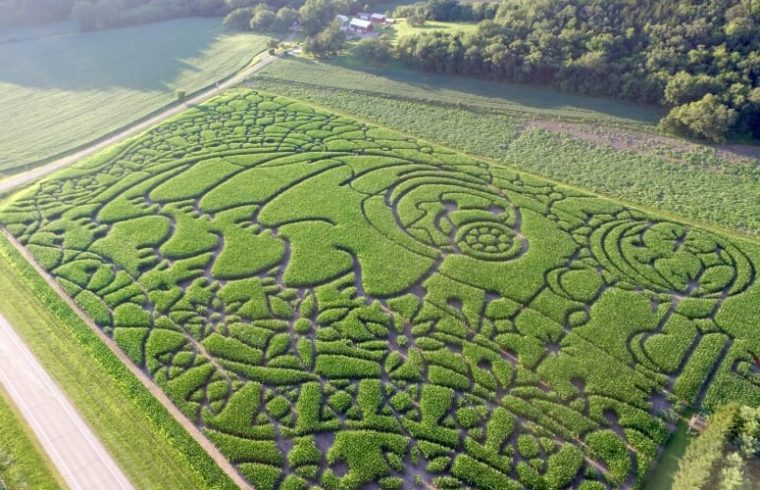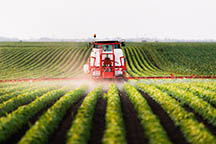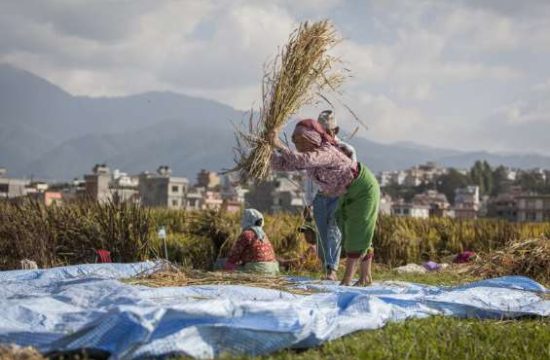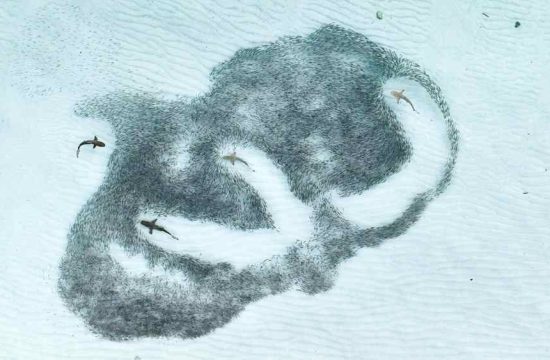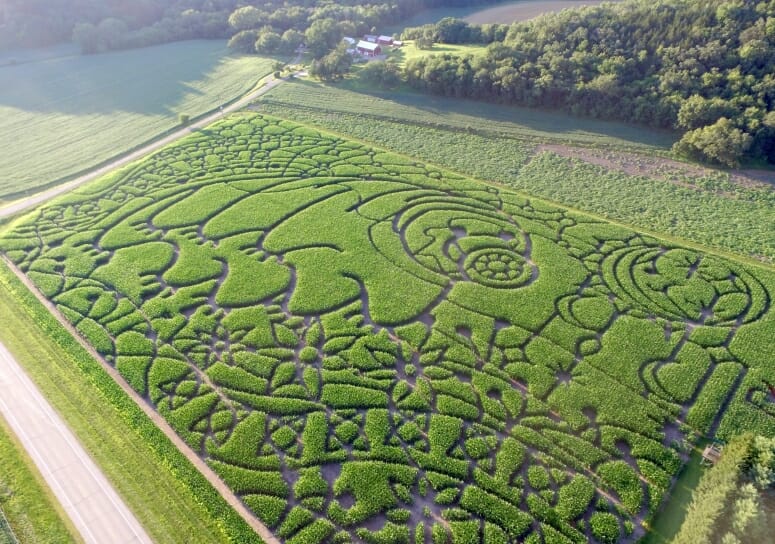
Fall is the season for corn mazes across the Midwest, but this year one Lodi farm is taking your traditional corn maze to the next level – by cutting it in the shape of science’s favorite microscopic critter, the tardigrade.
Tardigrades, also known as water bears, look kind of like a cross between a bear and a caterpillar, with eight knobby little legs and an odd-looking snout. But, according to University of Wisconsin-Madison soil microbiologist Thea Whitman, what’s so impressive about these tiny organisms is their ability to survive almost anywhere, from freezing ice to boiling water. Scientists have even sent them into the depths of space and seen them survive.
So, what better mascot for 2020, a year of one unprecedented challenge after another, says Angie Treinen, who owns a Madison-area farm with her family.
Treinen went to UW-Madison for her bachelor’s degree in zoology, after which she attended veterinary school. Treinen Farm was her husband Alan’s family farm, and in 2001, she and Alan created their very first corn maze. Now, every year, she takes charge of designing what the maze will look like.
In 2017, the Treinen Farm corn maze gained international fame for its science-themed design: a trilobite, which is an extinct organism that lived during the Cambrian period and also happens to be the Wisconsin state fossil. This year, Treinen chose another science-y critter as the focus of her design, the tardigrade, because of the message of resiliency it sends.
“We’re all worried about our country, our society,” Treinen says. “In the past, I have often really tried to say to people, ‘Hey, come up to the farm. Drop all your baggage or your stresses.’ This year, that’s even more important. [The tardigrade] is literally one of the most resilient animals on the planet, which is a theme for 2020.”
The actual maze design process, Treinen says, starts with some brainstorming. This year, Treinen originally wanted the maze in the shape of a wolf. But when the pandemic hit, she decided her guests needed something a little more uplifting – thus, she chose the tardigrade and its ability to survive at all costs.
Once she decides what the subject of the maze will be, Treinen starts drafting a design. While she doesn’t have a formal background in art, Treinen says the maze design gives her an outlet to express her creativity.
After the design’s all ready, Treinen prints it on grid paper and hands it off to her husband, who gets ready to carve it into the field with his crew. Usually, this process takes about a week, depending on weather conditions, Treinen says. First, the crew members have to put flags on the field marking important spots on the design, and then they come through with a commercial lawn mower to start cutting the design. Then, they use a tiller to carve out the path.
While many corn mazes use GPS signaling and fancier equipment, Treinen says her crew likes using their more traditional method because it ensures the design gets carved out perfectly.
“We cut it by hand with the crew… because of the number of trails and the intricacy of our design,” Treinen says. “We are always kind of concerned GPS might not be accurate enough, and also like our crew kind of likes to do it.”
Treinen first learned about tardigrades when she attended a science outreach event at the Wisconsin Institutes for Discovery. The tiny creatures enthralled her, and inspired her to learn more. Treinen says she hopes her maze encourages others to do the same.
“It’s that moment where you hear or find out about something that changes your whole way of looking at something,” Treinen says. “For me, I remember that moment when I learned about the water bear. I love that moment. And so that’s the kind of moment we love to share with visitors.”
Treinen says she hopes her maze can be a temporary respite from current events. She and others at the farm devised protocols for guests to keep up social distancing and protect each other from coronavirus. They’re limiting their capacity, and they closed all their indoor areas and attractions with high-touch surfaces. They will require masks anywhere where guests cannot keep six feet between themselves and others and, Treinen said, they’re debuting a set of hiking trails that guests can walk along to explore the natural area while staying safe and healthy.
Overall, Treinen says she’s glad that even in a pandemic, she still gets to share her creative visions with everyone coming to the farm.
“I love science. I love art. I love creative, weird stuff. And so it is so much fun to talk to people about whatever kind of weird stuff we decide to include for the year,” Treinen says. “I love making people think. It’s amazing – you have to think hard and you have to work together. Some people are like, ‘I don’t know if I can do it. Somebody’s gonna have to rescue me.’ No, it’ll be okay. We’ll figure it out.”
(Provided by wisc-news)


